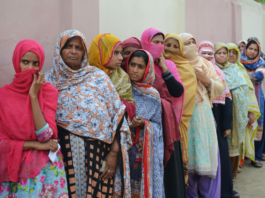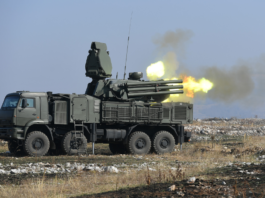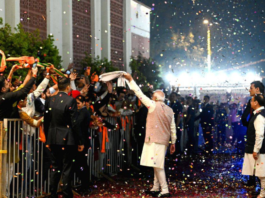
Israeli forces preparing to enter Gaza on a mission to destroy Hamas would face an increasingly capable adversary that has been secretly supported by a network that extends far beyond the small enclave to Iran and other Arab parties for years.
Six days ago, Hamas launched a murderous strike on southern Israel that was unparalleled for the organisation in terms of strategy and scope. The attack was a devastating illustration of the military prowess the organisation has developed since seizing control of Gaza in 2007.
“Necessity is the mother of invention,” said Ali Baraka, a senior Hamas official, adding that the group had long drawn on money and training from Iran and Iranian regional proxies like Lebanon’s Hezbollah, while bolstering its own forces in Gaza.
Difficulties in importing weapons meant that over the past nine years “we developed our capabilities and are able to manufacture locally”, said Baraka, who is based in Lebanon.
Hamas rockets had a maximum range of 40 km (25 miles) in the 2008 Gaza War, but by the 2021 Conflict, that range had increased to 230 km.
“They are a mini-army,” said a source close to Hamas in the Gaza Strip, who declined to be named due to the sensitivity of the matter. He said the group had a military academy training a range of specialisations including cyber security, and boasts a naval commando unit among its 40,000-strong military wing.
According to the website globalsecurity.org, Hamas had less than 10,000 fighters in the 1990s.
According to a regional security source who also declined to be identified, the group has been creating a network of tunnels under Gaza since the early 2000s to aid in fighter dispersal, house weapons facilities, and bring in weaponry from abroad. According to Hamas authorities, the group has obtained a variety of bombs, mortars, rockets, anti-tank, and anti-aircraft missiles.
Over time, the growing capabilities of Hamas have led to progressively destructive outcomes. During its 2008 invasion, Israel lost nine troops. The number increased to 66 in 2014.
After the most recent Gaza war in 2021, Hamas and an affiliated group called Palestinian Islamic Jihad managed to retain 40% of their missile inventories, a key target of the Israelis, according to the U.S. based non-profit Jewish Institute for National Security of America, keeping roughly 11,750 missiles compared with 23,000 before the conflict.
Israel, the US, the EU, Canada, Egypt, and Japan all classify Hamas as a terrorist organisation because its founding charter from 1988 called for the eradication of Israel.
According to Western authorities, Hamas has assisted Iran in realising its long-held goal of encircling Israel with hordes of paramilitaries, including other Palestinian factions and Lebanon’s Hezbollah. All are armed with cutting-edge weapons and have long been hostile to Israel’s occupation of Palestinian territory.
Although the group’s power base is still Gaza, its commanders are dispersed around the Middle East in places like Qatar and Lebanon. In advance of the anticipated ground assault that will follow days of Israeli bombardment that have killed over 1,800 Palestinians, it has urged Gazans not to accept Israel’s demand to leave.
Hamas launched more than 2,500 rockets during the attack on October 7, which was the worst breach in Israel’s defences in 50 years. Fighters using paragliders, motorbikes, and four-wheel drive vehicles overpowered Israeli forces and tore through towns and communities, murdering 1,300 people and kidnapping scores of others.
Iran acknowledges supporting and educating Hamas, but it denies any involvement in the attack, despite having hailed it.
Ismail Haniyeh, the head of Hamas, said that Iran had provided his organisation with $70 million in military assistance in an interview with Al Jazeera television last year.
“We have rockets that are locally manufactured but the long-range rockets came from abroad, from Iran, Syria and others through Egypt,” he added.
Approximately $100 million is given annually by Iran to Palestinian organisations like Hamas, Palestinian Islamic Jihad, and the Popular Front for the Liberation of Palestine-General Command, according to a 2020 report from the U.S. State Department.
According to a security official in Israel, Iran dramatically upped its yearly contribution to Hamas’ armed wing from $100 million to roughly $350 million in the last year.
On December 10, 1987, some Muslim Brotherhood members met the day after an Israeli army truck collided with a car carrying four Palestinian day labourers, killing all of them. This is when the idea for Hamas, which means enthusiasm in Arabic, first emerged. Following were protests with stone-throwing, strikes, and closures in Gaza.
They decided to publish a pamphlet on December 14 calling for resistance as the First Intifada, or revolt, against Israel, began after meeting at the home of Muslim cleric Sheikh Ahmed Yassin. It was their first public performance as a unit.
According to Western intelligence sources, Hamas started importing rockets, explosives, and other material from Iran after Israel withdrew from Gaza in 2005. They stated that they were smuggled into Gaza through a maze of tiny tunnels beneath the Sinai Peninsula after being trucked across Egypt and delivered via Sudan.
Other regional paramilitary partners also received supplies of weaponry, training, and money from Iran, which finally gave Tehran a dominant presence in Lebanon, Syria, Iraq, Yemen, and Gaza.
Some of these friends are connected by a “Shi’ite axis” that includes Shi’ite paramilitaries in Iraq, Hezbollah in Lebanon, and the Alawite minority, which rules Syria and is a branch of Shi’ite Islam.
Hezbollah is the crowning achievement of Iran’s militia network. It was founded in 1982 at the Iranian embassy in Damascus.
In 2000, Hezbollah forced Israel out of Lebanon by bombing American targets and pursuing a hostage-taking and hijacking strategy. Since then, it has steadily taken control of key state institutions in Lebanon.
When Israel deported 400 or so Hamas leaders to Lebanon in 1992, Iran grabbed the chance to co-opt Hamas, according to a source close to the organisation. The source went on to say that Iran and Hezbollah hosted Hamas members, shared military technology with them, and taught them how to make homemade bombs for suicide strikes.
The ultimate goal of the attack on Israel on October 7 was to win the release of all 5,000 Palestinian prisoners detained in Israeli jails, put an end to Israeli incursions on the Al Aqsa mosque, the third holiest site in Islam, and relieve a 16-year-old blockade of Gaza, according to Hamas spokesman Baraka.
He warned that if Israel’s ground offensive went ahead, blessed by the U.S. and Britain, the war wouldn’t be confined to Gaza but could spill over into a regional conflict.



